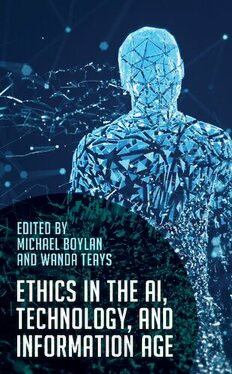
Ethics in the AI, Technology, and Information Age PDF
Preview Ethics in the AI, Technology, and Information Age
Ethics in the AI, Technology, and Information Age Edited by Michael Boylan M u aryMount niversity Wanda Teays M s M ’ u ount aint ary s niversity ROWMAN & LITTLEFIELD Lanham • Boulder • New York • London Acquisitions Editor: Natalie Mandziuk Acquisitions Assistant: Sylvia Landis Sales and Marketing Inquiries: textbooks@rowman. com Credits and acknowledgments for material borrowed from other sources, and reproduced with permission, appear on the appropriate pages within the text. Published by Rowman & Littlefield An imprint of The Rowman & Littlefield Publishing Group, Inc. 4501 Forbes Boulevard, Suite 200, Lanham, Maryland 20706 www .rowman .com 86-90 Paul Street, London EC2A 4NE, United Kingdom Copyright © 2022 by The Rowman & Littlefield Publishing Group, Inc. All rights reserved. No part of this book may be reproduced in any form or by any electronic or mechanical means, including information storage and retrieval systems, without written permission from the publisher, except by a reviewer who may quote passages in a review. British Library Cataloguing in Publication Information Available Library of Congress Cataloging- in- Publication Data Names: Boylan, Michael, editor. | Teays, Wanda, editor. Title: Ethics in the AI, technology, and information age / edited by Michael Boylan, Wanda Teays. Description: Lanham : Rowman & Littlefield, [2022] | Includes bibliographical references and index. Identifiers: LCCN 2021052276 (print) | LCCN 2021052277 (ebook) | ISBN 9781538160749 (cloth) | ISBN 9781538160756 (paperback) | ISBN 9781538160763 (ebook) Subjects: LCSH: Technology—Moral and ethical aspects. | Artificial intelligence—Moral and ethical aspects. | Internet—Moral and ethical aspects. Classification: LCC BJ59 .E865 2022 (print) | LCC BJ59 (ebook) | DDC 174/.96—dc23/eng/20211222 LC record available at https://lccn.loc.gov/2021052276 LC ebook record available at https://lccn.loc.gov/2021052277 The paper used in this publication meets the minimum requirements of American National Standard for Information Sciences—Permanence of Paper for Printed Library Materials, ANSI/NISO Z39.48-1992. Michael: To Andrew (my father) who thought there were no “downsides” to technology—especially after network radio and the refrigerator Wanda: To Silvio, whose interest in technology is only bounded by the constraints of time Contents Acknowledgments vii Preface ix PART ONE: THEORETICAL BACKGROUND Section 1: Ethical Theory, Applied Ethics, and Professional Ethics 1 Michael Boylan, “Ethical Reasoning” 5 2 Michael Boylan, “‘Nature’ as a Background Condition” 15 Section 2: Humans and Machines: A New Ethical Paradigm? 3 Morgan Luck and Stephen Clarke, “Transformative Technologies, the Status Quo, and (Religious) Institutions” 35 4 Felicia Nimue Ackerman, “Transhumanism: Is This a Step Forward?” 49 5 Mark Vopat, “AI and Human Rights: Present and Future Moral Challenges” 61 PART TWO: APPLICATIONS Section 1: The Practical Scope of Technology Ethics 6 David E. McClean, “Is There a Need for a New, a Technology, Ethic?” 79 7 Marvin T. Brown, “The Social Worlds of Technology” 89 Section 2: The Ownership of Technology and Technology Transfer 8 David Koepsell, “Ownership of Information Technology” 103 9 Luciano Floridi, “The Fight for Digital Sovereignty” 115 v vi CONTENTS Section 3: Information Technology and Social Media 10 Dean Cocking and Jeroen van den Hoven, “The Moral Fog of Social Media” 131 11 Dean Cocking and Brigid Evans, “Becoming Good and Growing Up Online” 141 12 Edward H. Spence, “The Privacy Paradox” 153 PART THREE: CHALLENGES Section 1: AI and Its Applications 13 Rita Manning, “AI in Health Care: Ethical Issues” 169 14 Jens Kipper, “The Ethics of Self-D riving Cars” 181 15 Sven Nyholm, “Moral Dilemmas of Self- Driving Cars” 193 Section 2: Cybersecurity 16 Seumas Miller, “AI and Criminal Justice: Individual Autonomy, Joint Rights, and Collective Responsibility” 207 17 Rosalie Waelen and Philip Brey, “Ethical Dimensions of Facial Recognition and Video Analytics in Surveillance” 217 18 Karsten Weber and Nadine Kleine, “Cybersecurity in Health Care” 233 Section 3: Technology and War 19 Wanda Teays, “The Ethics of Drone Killings and Assassinations” 257 20 Shannon E. French, “War and Technology: Should Data Decide Who Lives, Who Dies?” 277 Appendix: Films and Documentaries on Technology Ethics, Wanda Teays 295 Notes 297 Index 327 Acknowledgments We are grateful to our editor, Natalie Mandziuk, and the team at Rowman & Littlefield. Thank you so much for all your encouragement and support. Thanks also to the contributors to this timely anthology. We are grateful to you for the ideas and insights expressed in your chapters. And thanks to you, our readers, for sharing an interest in this growing field of technology ethics. vii Preface Some have claimed that the making of tools is what (in a primitive way) has separated us from other animals and has allowed the development of language— and reason itself.1 Thus, the relationship between technology and what it means to be human goes back to the very beginning. A more recent starting point might be the Industrial Revolution that continued for a hundred and fifty years and then gave way to the Information Age—including social communications, artificial intelligence, and an interface with robots and technology that influences almost everything from health to warfare. Thus, the way humans interface with technology creates a panoply of new possibilities of action—many of which bring with them ethical problems. We cannot be so overwhelmed with the efficiency of production provided by machines that we ignore moral problems that may be important. This conflict between prudential advantage and ethical norms is at the heart of applied ethics. It is our hope that this collection of essays helps readers think about some of these issues within domains in the world we live in. We seek to promote discussion on how we might take the best from technology while avoid- ing possible ethical pitfalls. This area of discourse will, we believe, continue to grow as one of the pri- mary areas of interest in applied ethics in the years to come. This is just the beginning! —Michael Boylan and Wanda Teays ix
